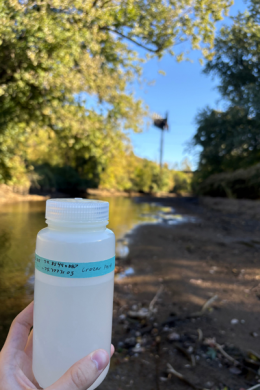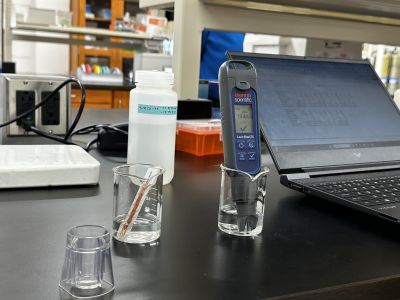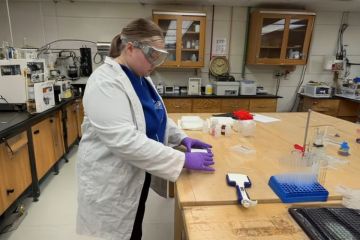Chemistry Lab Studies Water Pollution Ahead of Winter Salting in Delaware County

Winter in Pennsylvania is quickly approaching, and with it comes cold weather and icy roads that require plowing and salting. At Widener, the impending winter has created a learning opportunity.
Area scientists are looking at the effect winter road treatments have on local waterways through a project called the “Fall Salt Snapshot.” Widener is partnering on the program, and has served as one of several testing sites across Delaware County. Chemistry students have also processed samples collected as part of the initiative.
Hosted by the Stroud Water Research Center in collaboration with the Delaware County Office of Sustainability and more than 15 other community partners, the Fall Salt Snapshot encouraged community members to collect and submit water samples to designated testing locations with the goal of establishing how much salting the roads is contributing to water contamination. This regional effort is part of a larger project spanning much of the Mid-Atlantic region.
Students in Domhnall OShaughnessy’s analytical chemistry class and lab conducted testing of samples submitted to the university from community members, as well as samples collected by some of the students in the class. David Young, a junior pursuing a dual degree in chemistry and chemical engineering, was one of them.
“I thought it would be cool to have some samples of our own and do the full process start to finish,” said Young.
He drove to nearby Ridley, Pennsylvania and found a pre-selected location to collect a sample. After “a little outdoor exploring,” he was ready to bring his sample back to the lab to be tested along with other samples submitted by community members.
“The goal of the experiment is to figure out how much salt is getting into the water during winter salting when it gets icy,” said Young. “How we do that is by testing the water before we salt and after we salt, so this is the before stage.”
Young and his classmates tested the water using two different methods to determine how much chloride is in each sample. Road salt is typically made up of sodium chloride, the same chemical makeup as salt used on food. When salt mixes with water, the sodium and chloride break down and separate. This experiment focused on how much chloride was present in each of the samples.
Students used test strips and conductivity meters to measure chloride levels and found correlation between the two readings to report back to researchers. These samples will be used to compare with other regions as well as to samples collected at later dates after road salting has occurred. Ultimately, researchers hope to better understand the impact that salting roadways has on the environment and educate the public on alternative measures.
"Our initial feedback from groups is that the snapshot process is helping them see and understand their watersheds more deeply, particularly with regard to the many headwaters and tributaries that often go unnoticed, but which feed and sustain the larger and more prominent streams and rivers,” shares John Jackson, principal investigator of the Entomology Group and senior research scientist at Stroud Water Research Center.
After collecting the data needed for the Fall Salt Snapshot, the Widener class has continued to experiment on the samples to gain hands-on experience in the lab by testing for sodium and other metals. This type of independent lab experience helps not only sharpen students’ skills, it provides truly valuable experiences.
“We’re doing a real experiment here. It’s not the most complex thing, but the process of making sure that you have two methods and double checking yourself is important,” said Young. As a student “you do all of these labs for your curriculum and those are cool, but they’re designed to teach you certain things. There’s something about doing an experiment that you don’t know what’s going to happen.”





